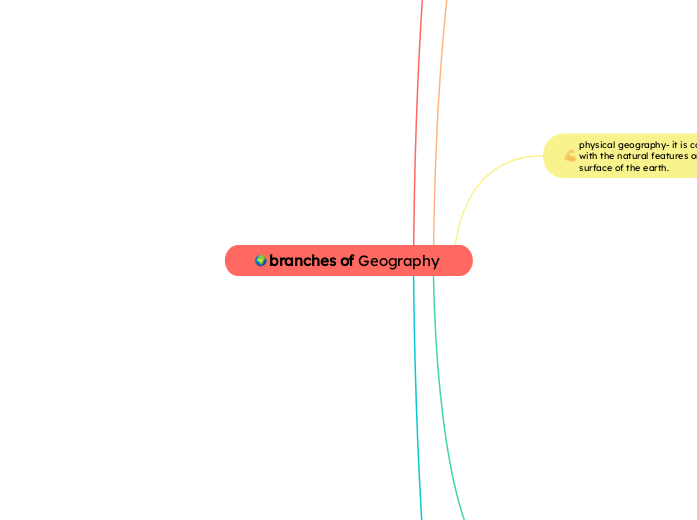branches of Geography
environmental geography- the branch of Geography that describes the spatial aspects of interactions between humans and the natural world. it requires an understanding of the dynamics of all the other branches of Geography, and often focus on conversation, planning and environmental issues.
biography- it is the study of geographic distribution of plants and animals on the earth.
water resources- geographers working in the water resources branch of Geography look at the distribution and use of water across the planet within the hydrologic cycle and human-developed systems for water storage, distribution and use.
climate- climate geographers investigate the distribution of long-term weather patterns and activity's of Earth's atmosphere
global geography- the study of global change explore long term changes occurring to the planet earth based on human impacts on the environment
cryosphere georgraphy- it is the study of ice spusifacly looking at glaciers and ince sheets
urban geography- the branch of the urban geography investigates the location, structure, development and growth of cities, from tiny villages to huge megalopolises
regional- the study on a certain region on the planet. Regional geographers focus on areas to study as large as a content or as small as an urban area.
quantitative- it uses the mathematical techniques and models to test hypotheses. quantitative methods are often used in many other branches of geography but some geographers specialize in quantitative methods specifically.
political- it investigates all aspects of boundaries, country, state, nation development, international organizations, diplomacy, internal country subdivisions, voting, and more.
physical geography- it is concerned with the natural features on or near the surface of the earth.
hazards- hazards geography combines work in physical and human geography. hazard geographers extreme events known as hazards or disasters and explore the human interactions and response to these unusual natural or technological events.
arid regions- Geographers studying arid regions examine the deserts and dry surfaces of the planet. They explore how humans, animals, and plants make their home in dry or arid regions and the use of resources in these regions.
mountain geography-Mountain geographers look at the development of mountain systems and at the humans who live in higher altitudes and their adaptations to these environments.
Geomorphology -Geomorphologists study the landforms of the planet, from their development to their disappearance through erosion and other processes
coastal/marine geography- Within coastal and marine geography, there are geographers researching the coastal environments of the planet and how humans, coastal life, and coastal physical features interact.
cartography- It has often been said that geography is anything that can be mapped. While all geographers know how to display their research on maps, the branch of cartography focuses on improving and developing technologies in map-making. Cartographers work to create useful high-quality maps to show geographic information in the most useful format possible.
soils- soil geographers study the upper layer of the lithosphere, the soil, of the earth and its categorization and patterns of distribution
geographic information- Geographic Information Systems (or GIS) is the branch of geography that develops databases of geographic information and systems to display geographic data in a map-like format. Geographers in GIS work to create layers of geographic data and when layers are combined or utilized together in complex computerized systems, they can provide geographic solutions or sophisticated maps with the press of a few keys.
economic geography- the distribution of productions and distribution of goods, wealth and spatial structure of the economic conditions.
remote sensing- Remote sensing utilizes satellites and sensors to examine features on or near the earth's surface from a distance. Geographers in remote sensing analyze data from remote sources to develop information about a place where direct observation is not possible or practical.
transportation-Transportation geographers research transportation networks (both private and public) and the use of those networks for moving people and goods.
agricultural and rural- Geographers in this branch study rural settlement, the distribution of agriculture and the geographic movement and access to agricultural products, and land use in rural areas.
tourism/sports- The study of leisure-time activities and their impact on local environments. As tourism is one of the world's largest industries, it involves a great number of people making very temporary migrations and is thus of great interest to geographers.
human geography- this branch studies people, there interactions with the earth and their organization of the spaces of the earths surface.
applied geography- Applied geographers use geographic knowledge, skills, and techniques to solve problems in everyday society. Applied geographers are often employed outside of the academic environment and work for private firms or governmental agencies.
education- Geographers working in the field of geographic education seek to give teachers the skills, knowledge, and tools they need to help combat geographic illiteracy and to develop future generations of geographers.
military geography- Practitioners of military geography are most often found within the military but the branch looks not only at the geographic distribution of military facilities and troops but also utilizes geographic tools to develop military solutions.
geography of religion- studies the geographic distribution of religious groups, their cultures, and built environments.
medical- Medical geographers study the geographic distribution of disease, illness, death and health care.
population- Often equated with demography but population geography is more than just patterns of birth, death, and marriage. Population geographers are concerned with the distribution, migration, and growth of population in geographic areas.
